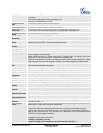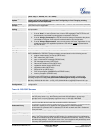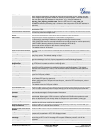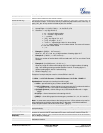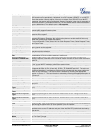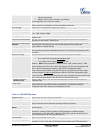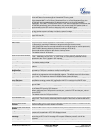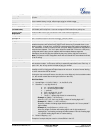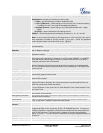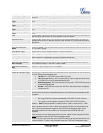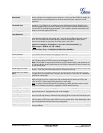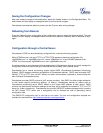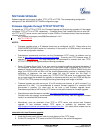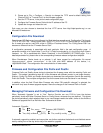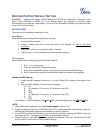
Grandstream Networks, Inc. HT503 User Manual Page 31 of 38
Firmware 1.0.4.2 Last Updated: 06/2011
incoming INVITE
call will be rejected. If this option is enabled, the device will not be able to make direct
IP calls.
SIP T1 Timeout
T1 is an estimate of the round-trip time between the client and server transactions.
If the network latency is high, select larger value for reliable usage.
SIP T2 Interval
Maximum retransmission interval for non-INVITE requests and INVITE responses.
DTMF Payload Type
Sends DTMF using RFC2833
Preferred DTMF method
(in listed order)
The HT503 supports up to 3 different DTMF methods including in-audio, via RTP
(RFC2833) and via Sip Info. User can configure DTMF method in a priority list.
Disable DTMF
Negotiation
Default is No. If set to yes, use above DTMF order without negotiation
Proxy Require
SIP Extension to notify SIP server that the unit is behind a NAT/Firewall.
Use NAT IP
NAT IP address used in SIP/SDP message. Default is blank.
Ring Timeout
Sets the time in which an incoming from PSTN call will stop ringing when not picked up.
Early Dial Default is No. Use only if proxy supports 484 response. This parameter controls
whether the phone will send an early INVITE each time a key is pressed when a user
dials a number. If set to “Yes”, an INVITE is sent using the dial-number collected thus
far. Otherwise, no INVITE is sent until the “(Re-)Dial” button is pressed or after about 5
seconds have elapsed. The “Yes” option should be used ONLY if there is a SIP proxy
configured and the proxy server supports 484 Incomplete Address response.
Otherwise, the call will likely be rejected by the proxy (with a 404 Not Found error).
Note: This feature is NOT designed to work with and should NOT be enabled for direct
IP-to-IP calling.
Dial Plan Prefix
Sets the prefix added to each dialed number.
Use # as Dial Key
This allows users to configure the # key as the “Send” (or “Dial”) key. If set to “Yes”, “#”
will send the number. In this case, this key is essentially equivalent to the “Dial” key. If
set to “No”, the “#” key can be included as part of a number.
Dian Plan
Dial plans work only for incoming calls from PSTN network. In case unconditional call
forward to VoIP is configured, dial plan feature will not work. In case of normal dialing
to VoIP, after dialing PSTN number,
If using the ‘hop on/hop off’ feature, the dial plan rules affect only the last called number
(i.e. the number called after receiving dial tone from the ATA).
Dial Plan Rules:
4. Accept Digits: 1,2,3,4,5,6,7,8,9,0 , *, #, A,a,B,b,C,c,D,d
5. Grammar: x - any digit from 0-9;
a. xx+ - at least 2 digits number;
b. xx. – at least 2 digits number;
c. ^ - exclude;
d. [3-5] - any digit of 3, 4, or 5;
e. [147] - any digit 1, 4, or 7;
f. <2=011> - replace digit 2 with 011 when dialing
• Example 1: {[369]11 | 1617xxxxxxx} –
Allow 311, 611, 911, and any 10 digit numbers of leading digits 1617
• Example 2: {^1900x+ | <=1617>xxxxxxx} –
Block any number of leading digits 1900 and add prefix 1617 for any dialed 7
digit numbers
• Example 3: {1xxx[2-9]xxxxxx | <2=011>x+} –
Allow any length of number with leading digit 2 and 10 digit-numbers of
leading digit 1 and leading exchange number between 2 and 9; If leading digit
is 2, replace leading digit 2 with 011 before dialing.
6. Default: Outgoing - {x+}
Example of a simple dial plan used in a Home/Office in the US:



